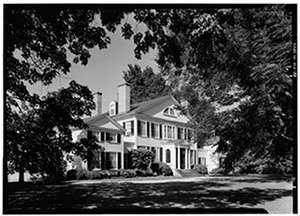Introduction

The Wye House mansion
from the Historic American
Buildings Survey, photographed by Jack E. Baucher
in 1963.
Throughout the eighteenth and nineteenth centuries, the Lloyd estate compiled census records of the enslaved at each of their properties, including first and last names, ages, and occupational details. The discovery of these lists gives the research on the slave labor at Wye House an individual perspective, reminding us that the institution of slavery is comprised of actual people instead of the anonymous "slaves."

A digital scan of a census
titled "Negroes Names"
from the Home House Farm (Wye House) in 1805.
Frederick Douglass, who was enslaved at the Wye House Plantation as a child in the 1820s, wrote about the plantation and people in his autobiographies Narrative of the Life of Frederick Douglass, an American Slave and My Bondage and My Freedom. Douglass' name does not appear in the censuses taken by the Lloyds, but instead on a list made by the man who officially owned him, Aaron Anthony. This list is not included in the database, since many of the people on it were not at Wye and because the two sets contain different kinds of information. The Aaron Anthony census may be viewed here.
Though these lists are important to the research that Archaeology in Annapolis conducts at Wye House, it is equally important that we make this database widely available, accessible, and usable. If you have any thoughts, suggestions, or questions about the content of this website or how it can better serve those interested in this information, please let us know by e-mailing us at annapolisarch@gmail.com or discussing on the Archaeology in Annapolis Blog. We would like this website to function as a starting point for a conversation about slavery, the importance of seeing the individual in the past, and the relevance of this research to the present and the descendants.
For more information about the Lloyd Family and their history, please see the records at the Maryland State Archives. There are compiled bibliographies of Col. Edward Lloyd VI, Edward Lloyd VII, and others.